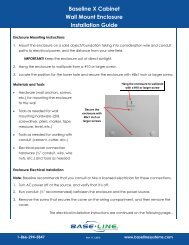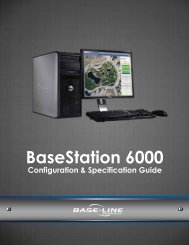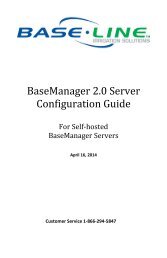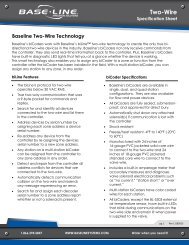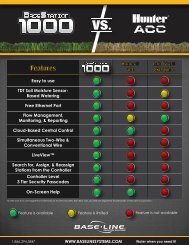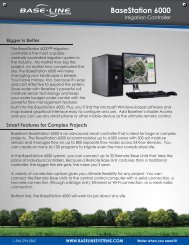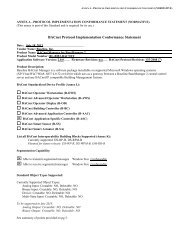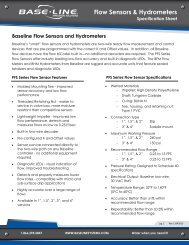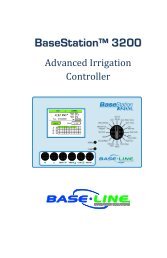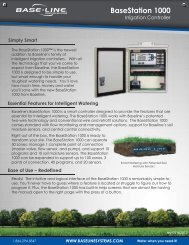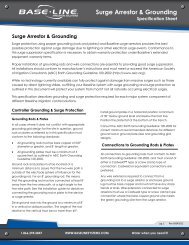BaseStation 3200 User Manual â 11.7.5.15 ... - Baseline Systems
BaseStation 3200 User Manual â 11.7.5.15 ... - Baseline Systems
BaseStation 3200 User Manual â 11.7.5.15 ... - Baseline Systems
You also want an ePaper? Increase the reach of your titles
YUMPU automatically turns print PDFs into web optimized ePapers that Google loves.
<strong>BaseStation</strong> <strong>3200</strong> Advanced Irrigation Controller <strong>Manual</strong><br />
To understand soil moisture based smart irrigation, you also need to understand the following industry standard<br />
terms for soil moisture content.<br />
Drier Wetter<br />
Saturation<br />
Field Capacity<br />
Maximum<br />
Allowed<br />
Depletion (MAD)<br />
Permanent Wilt<br />
Point<br />
Oven Dry<br />
The soil pores are filled with water and nearly all of the air in the soil has been<br />
displaced by water. Gravity exerts force on the water contained in saturated<br />
soils, moving it deeper into the ground (if possible). When this “gravitational<br />
water” moves down through the soil, it becomes unavailable to plants.<br />
The level of soil moisture left in the soil after drainage of the gravitational<br />
water. If you irrigate to a level above field capacity, it will result in runoff or<br />
drainage as gravitational water.<br />
When the soil moisture content reaches this level, irrigation needs to start. In<br />
most cases, the maximum allowed depletion level is well before the plants<br />
begin to show visible signs of stress. Irrigators typically start watering at or<br />
before MAD is reached because they do not want their landscapes to show signs<br />
of stress.<br />
The minimal point of soil moisture where the plants wilt and begin to die off.<br />
When soil is dried in an oven, nearly all water is removed. This moisture content<br />
is used to provide a reference for measuring saturation, field capacity, and<br />
MAD.<br />
One key point is that water applied above field capacity is generally wasted – it gravitationally moves down<br />
through the soil and becomes unavailable to plants. Excess water will also leech nutrients from the soil into deeper<br />
soil layers, reducing the efficiency of fertilizers and soil treatments.<br />
To understand field capacity, it is often useful to think of a sponge. If you dunk a sponge in a bucket of water and<br />
pull it out, water will gravimetrically drain from the sponge for a period of time. When the dripping stops, the<br />
sponge will still be very wet. This moisture level is roughly equivalent to field capacity in soils – water is no longer<br />
draining into lower soil layers and is held in the root zone of the plants.<br />
When your irrigation system maintains soil moisture content between field capacity and maximum allowed<br />
depletion, you will find that your plants are healthier and your water use actually decreases. Studies also show that<br />
appropriately varying the time between irrigation events in order to allow the soil to dry to the chosen depletion<br />
point promotes deeper root growth and subsequently more efficiency and drought tolerance from the plants.<br />
How to Use Soil Moisture Sensors Successfully<br />
The first key for success with soil moisture sensors is to consider the hydrozones that exist in your landscaping. A<br />
hydrozone is a grouping of plants that have similar water usage and delivery characteristics and can be watered<br />
the same. For example, each of the following landscaping areas is a separate hydrozone:<br />
• Grass in full sun with rotors<br />
• Grass in full sun with sprays<br />
• Drip zones in full sun<br />
• Grass in shade with rotors<br />
• Grass in shade with sprays<br />
• Drip zones in shade<br />
Page 3



